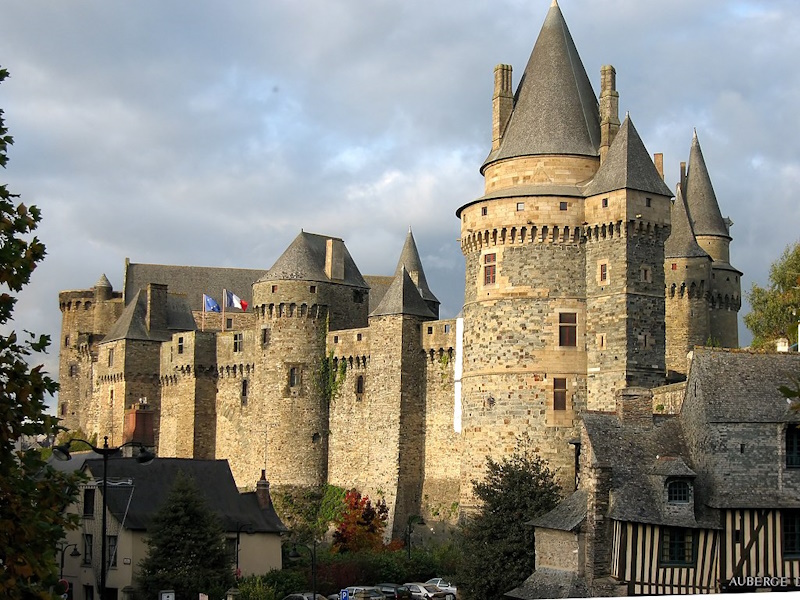7 Impressive Châteaux in Brittany Worth Visiting
The châteaux of Brittany range from defensive fortresses to luxurious residences, built between the 11th and 16th centuries.
Many were constructed to protect Brittany’s borders, while others served as retreats for the Dukes of Brittany. These feature strong defensive walls, moats, and towers, some with high military importance.
Others were built in the 19th century using a mix of modern and traditional styles. Many are now open to the public. Here are 10 of the most impressive!
1. Château de Josselin

Château de Josselin is a majestic castle built in the 11th century. It sits above the Oust River with stunning views of the surrounding landscape.
The castle has been home to the powerful Rohan family for over 1,000 years. Its three towers, connected by stone walls, reflect the strength and prestige of the Rohan dynasty.
This is a great example of medieval architecture, with a rich history of defense and royal heritage.
Location: Josselin, Morbihan – website
Key Facts: Built in the 11th century and expanded in the 15th century. Still owned by the Rohan family.
2. Château de Fougères

A massive medieval fortress that dominates the surrounding valley. With its huge walls, 13 impressive towers, and deep moat, it was a stronghold during centuries of conflict.
Visitors can walk along the ramparts and explore the castle’s history through exhibits. The castle has great panoramic views of the old town and countryside.
Location: Fougères, Ille-et-Vilaine – website
Key Facts: Built in the 11th century and expanded in the 12th and 15th centuries. One of Europe’s largest medieval castles.
3. Château de Combourg

Château de Combourg has for centuries been a symbol of Brittany’s medieval power. Its thick stone walls and pointed towers give it a storybook look.
The château played a key role in guarding Brittany’s borders during the Middle Ages. It was made famous by writer Chateaubriand who lived there as a child.
The castle is surrounded by a peaceful lake and lush trees. Legends of ghosts and mysterious sounds have been tied to its halls.
Location: Combourg, Ille-et-Vilaine – website
Key Facts: Built in the 11th century. Restored in the 19th century.
4. Château de Suscinio

Château de Suscinio was a favorite retreat for the Dukes of Brittany. Sitting near the coast and surrounded by marshes, it was built as both a fortress and a hunting lodge.
Its high stone walls and towers once guarded the ducal court. Visitors can see the grand halls and walk along the battlements.
Location: Sarzeau, Morbihan – website
Key Facts: Built in the 13th century. Features two moats and six towers.
5. Château de Dinan

This is a solid fortress that sits high above the Rance River. Built as part of Dinan’s medieval defenses, it guarded one of Brittany’s most important trade routes.
The castle’s round keep and thick walls were built to withstand sieges. With its position on the town’s ramparts, it’s connected to Dinan’s history of commerce and warfare.
It was a key stronghold during Brittany’s battles for independence.
Location: Dinan, Côtes-d’Armor – website
Key Facts: Built in the 14th century. Includes a large keep and connected ramparts.
6. Château de Kerjean

Château de Kerjean was built in the 16th century as a symbol of Breton nobility’s wealth during the Renaissance.
Its architecture reflects elegance and strength, with fortified bastions and decorative details.
During the French Revolution, much of its interior was looted, and the estate fell into decline.
Location: Saint-Vougay, Finistère – website
Key Facts: Built in the 16th century by the Barbier family. Renaissance-style architecture.
7. Château de Trévarez

This château was built in the late 1800s as a luxurious getaway for a wealthy industrialist. It stands out for its striking pink granite facade, a blend of modern and traditional styles.
The château’s large gardens are filled with rare plants. Over time, the castle went from being a private estate to a historical site open to the public.
Location: Saint-Goazec, Finistère – website
Key Facts: Built in the 1890s. Known for its unique pink granite and large gardens. Listed as a historic monument.
8. Château de Brest

Château de Brest is one of the oldest military fortresses in France, with origins dating back to Roman times!
Positioned at the entrance of the Penfeld River, it played a key role in defending the coast and controlling maritime routes.
Over the centuries, it has been expanded and modified, and is now a naval museum.
Location: Brest, Finistère – website
Key Facts: Originally a Roman fort. Expanded in the 14th and 17th centuries.
9. Château de Vitré

This castle is a mix of medieval and Gothic architecture, with a massive keep and impressive ramparts. It played a key role during the Wars of Breton Succession.
Built in the 11th century, its location helped control the region’s trade and defense. It was a stronghold in the heart of the town, guarding the entrance to Brittany.
Location: Vitré, Ille-et-Vilaine – website
Key Facts: Features a Gothic chapel and defensive ramparts.
10. Château de Tonquédec

Château de Tonquédec is an impressive ruin in the quiet countryside of Côtes-d’Armor. Built in the 13th century, it was once a powerful fortress defending the region.
With its crumbling towers and stone walls surrounded by thick forests, the castle has a mysterious feel reinforced by local legends.
Location: Tonquédec, Côtes-d’Armor – website
Key Facts: Built in the 13th century. Partially destroyed in the 17th century. Known for its ghost stories and picturesque ruin.
